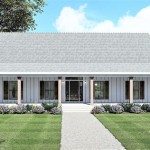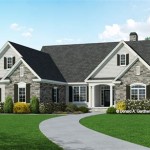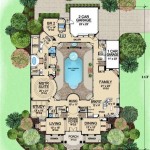What is a Building Elevation Plan?
A building elevation plan, often simply referred to as an elevation, is a vital component of architectural and construction documentation. It is a two-dimensional orthographic projection of a building's façade, depicting its external appearance from a specific viewpoint. Unlike floor plans, which show the layout of rooms and interior spaces, or site plans, which illustrate the building's position on the land, an elevation focuses on the building's vertical plane. It provides a detailed representation of the building's height, width, and architectural features as seen from a single perspective.
Elevations are crucial for various stages of a building project, from initial design and client presentations to obtaining permits and guiding construction. They offer a visual understanding of the building's aesthetics, materials, and overall design. These plans enable architects, engineers, contractors, and clients to communicate effectively about the building's appearance and ensure that the finished product aligns with the intended vision. Accurate and comprehensive elevations are essential for a successful building project.
Key Point 1: Purpose and Importance of Building Elevations
The primary purpose of a building elevation is to illustrate the external appearance of a building from a specific vantage point. Elevations are typically created for each side of the building – front, rear, left, and right – providing a complete visual representation of the structure. These drawings are not merely artistic renderings; they are precise technical documents that convey essential information about the building's design and construction.
Elevations perform several important functions. First, they provide a clear visualization of the building's aesthetics, including its architectural style, proportions, and the arrangement of windows, doors, and other features. This visual representation is critical for client presentations, enabling them to understand the building's overall look and feel before construction begins. Elevations also help in making design decisions, such as choosing appropriate materials and colors, as they provide a visual context for evaluating different options.
Furthermore, elevations are crucial for obtaining building permits. Local building authorities review elevations to ensure that the proposed building complies with zoning regulations, building codes, and aesthetic guidelines. Accurate elevations demonstrate that the building meets the required standards and are an essential part of the permit application process. They help demonstrate adherence to height restrictions, setback requirements, and other regulations related to the building's appearance and integration with the surrounding environment.
During construction, elevations serve as a guide for contractors. They provide detailed information about the placement of windows, doors, and other architectural elements, ensuring that the building is constructed according to the design specifications. Elevations also help contractors understand the materials and finishes to be used on the exterior, allowing them to order the correct quantities and ensure proper installation. In essence, elevations act as a visual blueprint for the construction team, minimizing errors and ensuring that the finished building matches the architect's vision.
Finally, elevations are useful for marketing and sales purposes. They can be used to create promotional materials such as brochures, websites, and renderings that showcase the building's design and attract potential buyers or tenants. High-quality elevations can help to convey the building's unique features and aesthetic appeal, making it more attractive to prospective customers. In the context of large developments, elevations can offer a cohesive visual representation of the entire project.
Key Point 2: Components and Information Included in a Building Elevation
A comprehensive building elevation includes various components and essential information that collectively convey the building's external appearance and specifications. These components include the representation of the building's façade, the surrounding ground level, and annotations that provide details about materials, dimensions, and other relevant features.
The primary element of an elevation is the depiction of the building's façade. This includes the precise placement of windows, doors, roofs, eaves, and other architectural elements. The elevation shows the type, size, and style of each feature, as well as its relationship to the overall design. For example, the drawing will indicate window shapes (e.g., arched, rectangular, or bay), door styles (e.g., paneled, sliding, or French), and roof types (e.g., gable, hip, or flat). These details contribute to the overall aesthetic of the building and are essential for accurate construction.
The elevation also illustrates the materials used on the building's exterior. This includes the type of siding (e.g., brick, wood, stucco, or metal), roofing materials (e.g., asphalt shingles, tiles, or metal panels), and the finishes applied to windows, doors, and trim. The elevation may use hatching, shading, or color to represent these materials visually. In addition, the elevation should include annotations that identify the specific materials and finishes to be used, such as the brand, color, and texture. This information is crucial for ensuring that the building is constructed with the intended materials and that the overall design is consistent throughout.
Dimensions are a critical part of a building elevation. The elevation should include dimensions for the building's height, width, and other key features. These dimensions provide precise measurements that contractors can use to ensure that the building is constructed accurately. Dimensions are typically shown in feet and inches, and they may be annotated with notes that clarify their meaning. For example, the elevation may include dimensions for the height of each floor, the width of windows and doors, and the distance between architectural elements.
The elevation also indicates the ground level and any landscaping features that are visible from the elevation viewpoint. This helps to show how the building relates to its surroundings and how it sits on the site. The elevation may include representations of trees, shrubs, sidewalks, and other landscape elements. It may also show the grade of the land around the building, indicating whether the site is level, sloping, or terraced. Furthermore, details such as gutters, downspouts, and exterior lighting fixtures are typically included to provide a comprehensive view of the building’s external features.
Annotations are used to provide additional information about the building's features and specifications. These annotations may include notes about materials, dimensions, construction details, and other relevant information. Annotations are typically placed near the features they describe and are connected to them with leader lines. They should be clear, concise, and easy to read. The annotations help to ensure that the elevation is fully understood and that the building is constructed according to the design specifications.
Key Point 3: Types of Building Elevations and Their Uses
Building elevations are categorized based on their orientation relative to the building and the level of detail they provide. The most common types include front elevations, rear elevations, side elevations, and interior elevations. Each type serves a specific purpose and provides unique information about the building's design and construction.
Front elevations, also known as façade elevations, illustrate the main entrance or the most visually prominent side of the building. They typically show the building's architectural style, main features, and overall appearance. Front elevations are often used for client presentations and marketing materials because they provide the most visually appealing representation of the building. They showcase the building's design intent and help to create a positive impression.
Rear elevations depict the back side of the building. While often less ornate than front elevations, rear elevations are still essential for providing a complete visual representation of the building. They show the placement of windows, doors, and other features on the back side, as well as any service entrances or utilitarian elements. Rear elevations are important for ensuring that the building's design is consistent on all sides and that the back side is aesthetically pleasing as well.
Side elevations represent the left and right sides of the building. These elevations show the building's profile and how it relates to the surrounding environment. Side elevations are essential for understanding the building's proportions, the placement of windows and doors, and the relationship between different parts of the building. They also show the building's setbacks from property lines, which is important for ensuring compliance with zoning regulations.
Interior elevations, unlike the other types, focus on the interior walls of a room or space. They illustrate the height, width, and features of the walls, including the placement of windows, doors, cabinets, fixtures, and decorative elements. Interior elevations are essential for designing and constructing interior spaces. They provide detailed information about the appearance of the walls, the location of electrical outlets and switches, and the placement of furniture and accessories. Interior elevations are commonly used in kitchen and bathroom design to specify the placement of cabinets, countertops, and appliances.
In addition to these standard types of elevations, there are also specialized elevations that provide more detailed information about specific features or parts of the building. For example, a sectional elevation shows the building cut vertically, revealing the interior structure and the relationship between different floors. A detailed elevation provides a close-up view of a specific architectural element, such as a window, door, or trim. These specialized elevations are used when more detailed information is needed for design review, construction, or renovation purposes.
The choice of which type of elevation to use depends on the specific needs of the project. For initial design presentations, front elevations are usually sufficient. For obtaining building permits, a complete set of elevations, including front, rear, and side elevations, is required. For detailed construction documents, specialized elevations may be used to provide additional information about specific features. By understanding the different types of building elevations and their uses, architects, engineers, contractors, and clients can ensure that the building is designed and constructed accurately and effectively.

What Are Elevations Building Design House

Exterior Elevations

Floor Plan And Elevations Of Urban Residential Building Model Scientific Diagram

Scheme Of The Tested Single Family House A Front Elevation B Scientific Diagram

Architecture House Plan And Elevation Complete Drawing Cadbullb Bungalow Floor Plans Building Designs

Plan Elevation Section Views And Details Mep Academy

How To Draw Elevations

Residential Building Front Elevation Design 1824 Square Feet Designing

Proposed Residential Building Plan And Elevation Design Autocad Drawing Cadbull

What Is Elevation Does House Mean Blog








